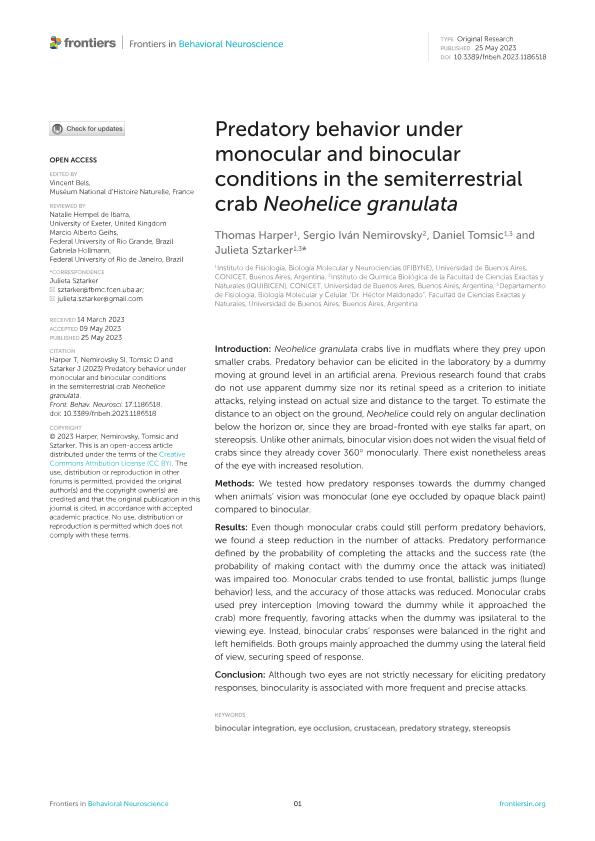Mostrar el registro sencillo del ítem
dc.contributor.author
Harper, Thomas
dc.contributor.author
Nemirovsky, Sergio Ivan

dc.contributor.author
Tomsic, Daniel

dc.contributor.author
Sztarker, Julieta

dc.date.available
2024-02-23T14:51:10Z
dc.date.issued
2023-05
dc.identifier.citation
Harper, Thomas; Nemirovsky, Sergio Ivan; Tomsic, Daniel; Sztarker, Julieta; Predatory behavior under monocular and binocular conditions in the semiterrestrial crab Neohelice granulata; Frontiers Media; Frontiers in Behavioral Neuroscience; 17; 5-2023; 1-11
dc.identifier.issn
1662-5153
dc.identifier.uri
http://hdl.handle.net/11336/228197
dc.description.abstract
Introduction: Neohelice granulata crabs live in mudflats where they prey upon smaller crabs. Predatory behavior can be elicited in the laboratory by a dummy moving at ground level in an artificial arena. Previous research found that crabs do not use apparent dummy size nor its retinal speed as a criterion to initiate attacks, relying instead on actual size and distance to the target. To estimate the distance to an object on the ground, Neohelice could rely on angular declination below the horizon or, since they are broad-fronted with eye stalks far apart, on stereopsis. Unlike other animals, binocular vision does not widen the visual field of crabs since they already cover 360° monocularly. There exist nonetheless areas of the eye with increased resolution. Methods: We tested how predatory responses towards the dummy changed when animals’ vision was monocular (one eye occluded by opaque black paint) compared to binocular. Results: Even though monocular crabs could still perform predatory behaviors, we found a steep reduction in the number of attacks. Predatory performance defined by the probability of completing the attacks and the success rate (the probability of making contact with the dummy once the attack was initiated) was impaired too. Monocular crabs tended to use frontal, ballistic jumps (lunge behavior) less, and the accuracy of those attacks was reduced. Monocular crabs used prey interception (moving toward the dummy while it approached the crab) more frequently, favoring attacks when the dummy was ipsilateral to the viewing eye. Instead, binocular crabs’ responses were balanced in the right and left hemifields. Both groups mainly approached the dummy using the lateral field of view, securing speed of response. Conclusion: Although two eyes are not strictly necessary for eliciting predatory responses, binocularity is associated with more frequent and precise attacks.
dc.format
application/pdf
dc.language.iso
eng
dc.publisher
Frontiers Media

dc.rights
info:eu-repo/semantics/openAccess
dc.rights.uri
https://creativecommons.org/licenses/by-nc-sa/2.5/ar/
dc.subject
BINOCULAR INTEGRATION
dc.subject
CRUSTACEAN
dc.subject
EYE OCCLUSION
dc.subject
PREDATORY STRATEGY
dc.subject
STEREOPSIS
dc.subject.classification
Zoología, Ornitología, Entomología, Etología

dc.subject.classification
Ciencias Biológicas

dc.subject.classification
CIENCIAS NATURALES Y EXACTAS

dc.title
Predatory behavior under monocular and binocular conditions in the semiterrestrial crab Neohelice granulata
dc.type
info:eu-repo/semantics/article
dc.type
info:ar-repo/semantics/artículo
dc.type
info:eu-repo/semantics/publishedVersion
dc.date.updated
2024-02-22T11:25:11Z
dc.journal.volume
17
dc.journal.pagination
1-11
dc.journal.pais
Suiza

dc.description.fil
Fil: Harper, Thomas. Consejo Nacional de Investigaciones Científicas y Técnicas. Oficina de Coordinación Administrativa Ciudad Universitaria. Instituto de Fisiología, Biología Molecular y Neurociencias. Universidad de Buenos Aires. Facultad de Ciencias Exactas y Naturales. Instituto de Fisiología, Biología Molecular y Neurociencias; Argentina
dc.description.fil
Fil: Nemirovsky, Sergio Ivan. Consejo Nacional de Investigaciones Científicas y Técnicas. Oficina de Coordinación Administrativa Ciudad Universitaria. Instituto de Química Biológica de la Facultad de Ciencias Exactas y Naturales. Universidad de Buenos Aires. Facultad de Ciencias Exactas y Naturales. Instituto de Química Biológica de la Facultad de Ciencias Exactas y Naturales; Argentina
dc.description.fil
Fil: Tomsic, Daniel. Consejo Nacional de Investigaciones Científicas y Técnicas. Oficina de Coordinación Administrativa Ciudad Universitaria. Instituto de Fisiología, Biología Molecular y Neurociencias. Universidad de Buenos Aires. Facultad de Ciencias Exactas y Naturales. Instituto de Fisiología, Biología Molecular y Neurociencias; Argentina
dc.description.fil
Fil: Sztarker, Julieta. Consejo Nacional de Investigaciones Científicas y Técnicas. Oficina de Coordinación Administrativa Ciudad Universitaria. Instituto de Fisiología, Biología Molecular y Neurociencias. Universidad de Buenos Aires. Facultad de Ciencias Exactas y Naturales. Instituto de Fisiología, Biología Molecular y Neurociencias; Argentina
dc.journal.title
Frontiers in Behavioral Neuroscience
dc.relation.alternativeid
info:eu-repo/semantics/altIdentifier/url/https://www.frontiersin.org/articles/10.3389/fnbeh.2023.1186518/full
dc.relation.alternativeid
info:eu-repo/semantics/altIdentifier/doi/http://dx.doi.org/10.3389/fnbeh.2023.1186518
Archivos asociados
